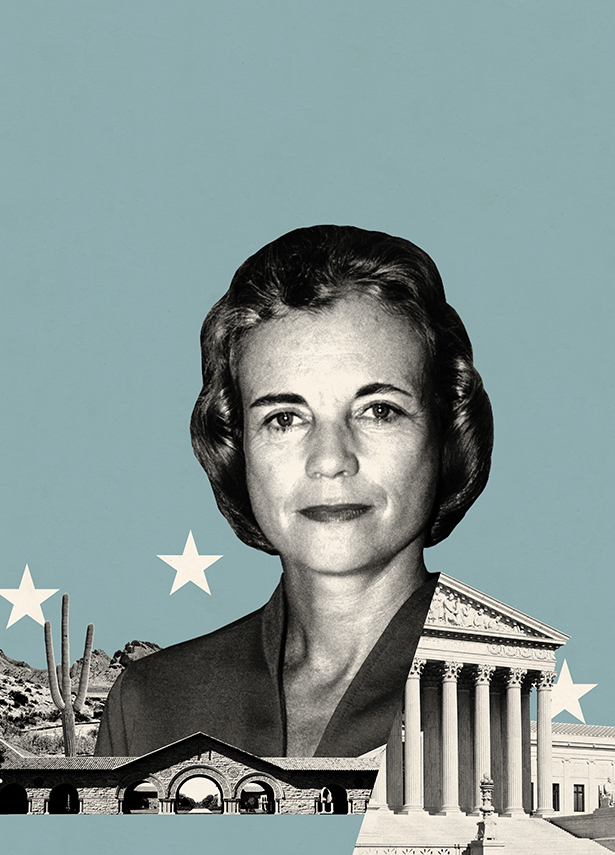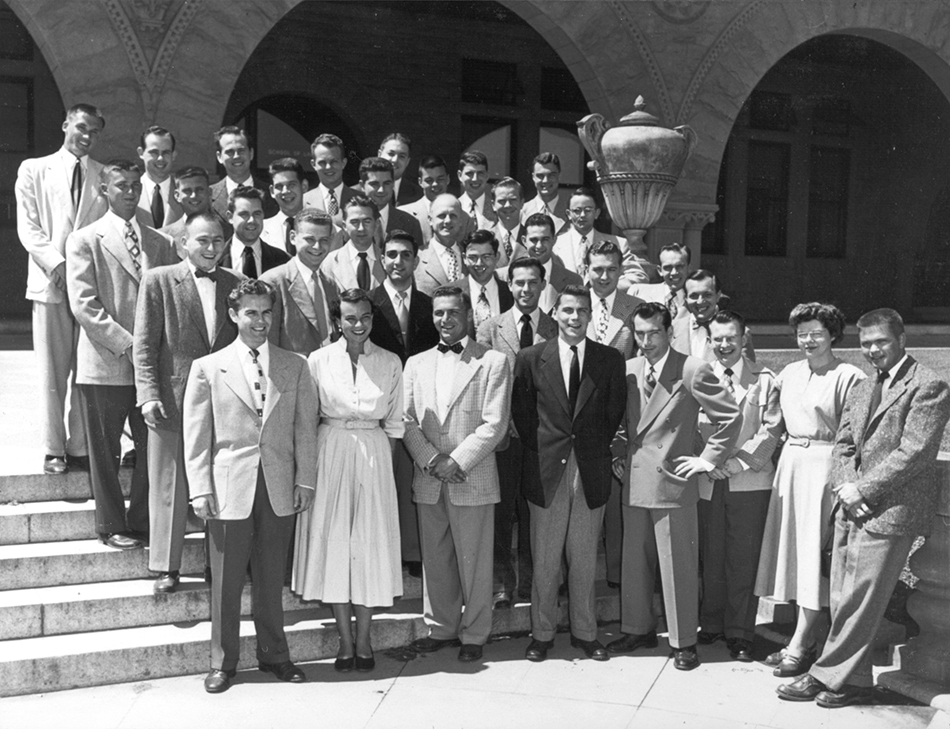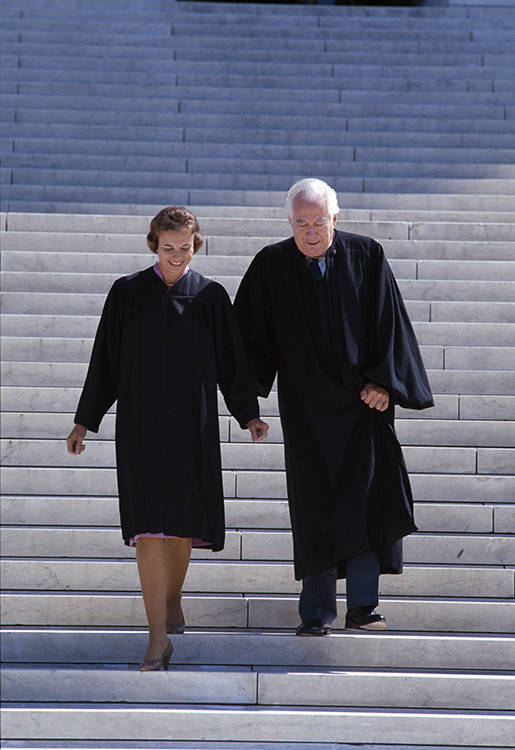An Influence Far Beyond the Court
Justice Sandra Day O’Connor, LLB ’52 (BA ’50), was the first woman appointed to the U.S. Supreme Court, but her legacy cannot be confined to cases alone.

During her quarter-century as an associate justice on the U.S. Supreme Court, Sandra Day O’Connor, LLB ’52 (BA ’50), was in the majority or plurality of countless high-profile decisions and wrote landmark opinions in polarizing cases dealing with abortion, affirmative action, and military confinement, among other hot-button issues.
But Stanford Law School Professor Jeffrey L. Fisher best remembers a lesser-known case. Davis v. Monroe County Board of Education asked whether a school board could be held liable under Title IX of the Education Amendments Act of 1972 for failing to address student-on-student sexual harassment. The case was argued and decided in 1999, while Fisher served as a clerk for Justice John Paul Stevens.
O’Connor wrote the 5-4 opinion holding that school boards could indeed be held liable for such failures, drawing a sharp dissent from Justice Anthony M. Kennedy (BA ’58), who asserted that the majority’s decision flew in the face of federalism. O’Connor was a fierce proponent of states’ rights, but she did not believe lofty principles of democratic governance were in need of defense in the case.
In announcing her decision from the bench, she addressed Kennedy’s criticism directly.
“The dissent urges that the Court’s holding today will teach little Johnny a perverse lesson in federalism,” she said. “In fact, Title IX works to ensure that little Mary may attend class, unhindered by severe and pervasive acts of sexual harassment by her classmate.”
Fisher says he remembers the moment “vividly . . . the first woman on the Court, saying this to four men who were all dissenting.”
“She wasn’t less conservative than Justice Kennedy, but, on this issue, she sure saw it differently,” he remembers. “I thought that was a great example: It matters who is on the Supreme Court.”
O’Connor, who died at the age of 93 on December 1, 2023, was often called “the most powerful woman in America” for the decisive role she played in so many groundbreaking cases. She was an icon of the law, revered for her work as a pragmatic and non-ideological justice, in support of the rule of law around the world, and, after her retirement, on behalf of civics education in the United States.
But, for those who worked closely with her, the legacy she leaves behind is also highly personal: the morning exercise classes she hosted; the Southwestern meals she prepared; the outings she organized; and her intense focus on whatever task was at hand, from wrapping Christmas gifts for her family to deciding the scope of the U.S. Constitution.
“Justice O’Connor was unusually kind, direct, straightforward, and personable,” says Susan Dunn, JD ’86, a retired corporate attorney who clerked for O’Connor in 1987. “It might be that, as the first woman justice of the Supreme Court, she didn’t have a model to follow or a format to fit into. She would just be herself.”
An Instinct for the Middle Ground
O’Connor was outspoken in her dislike of the term “swing vote,” and yet that was her role for many years—a reality that several of her clerks attribute to a conscious effort to approach each case on its own merits.
“People talk about a swing vote as if the other eight justices have lined up and you’re in the middle choosing—that’s not how it works,” says Benjamin J. Horwich, JD ’03, a 2005 clerk. “Rather, she was in the middle of the conversation because of her willingness to engage with her colleagues.”
Justice Kennedy, who retired in 2018, also often cast the deciding vote in cases, but Michael W. McConnell, Richard and Frances Mallery Professor of Law and faculty director of the Stanford Constitutional Law Center, says he and O’Connor played different roles. “I think of her as being the ballast, while I think of him as jumping from one side of the boat to the other,” he says. “He often advocated very strongly for one side or the other. She was always looking for a kind of middle ground with nuance.”
McConnell says O’Connor was particularly influential in cases involving federalism. One early such case was FERC v. Mississippi, in 1982, when she concurred in part and dissented in part with a majority decision upholding aspects of a legislative package designed to address a national energy crisis.

“State legislative and administrative bodies are not field offices of the national bureaucracy,” she wrote. “Nor are they think tanks to which Congress may assign problems for extended study. Instead, each state is sovereign within its own domain, governing its citizens and providing for their general welfare. While the Constitution and federal statutes define the boundaries of that domain, they do not harness state power for national purposes.”
A decade later, in New York v. United States, she was in the majority, helping create what became known as the “anti-commandeering” doctrine. In striking down as unconstitutional one part of a law aimed at increasing disposal of radioactive waste in individual states, she distinguished between Congress incentivizing states to participate in some effort and forcing them to do so.
“Where Congress encourages state regulation rather than compelling it, state governments remain responsive to the local electorate’s preferences; state officials remain accountable to the people,” she wrote. “But where the Federal Government directs the states to regulate, it may be state officials who will bear the brunt of public disapproval, while the federal officials who devised the regulatory program may remain insulated from the electoral ramifications of their decision.”
A Voice of Pragmatism
O’Connor was pragmatic in her approach to cases, former clerks say, always taking into account the effects of the High Court’s decisions on lower courts and the public.
Horwich says Food and Drug Administration v. Brown & Williamson Tobacco “was an amazing confluence of some of the things that made Justice O’Connor’s outlook both legally sophisticated and very pragmatic.”
In the 2000 case, which held that the FDA did not have the authority to regulate tobacco products, O’Connor wrote: “Congress, for better or for worse, has created a distinct regulatory scheme for tobacco products, squarely rejected proposals to give the FDA jurisdiction over tobacco, and repeatedly acted to preclude any agency from exercising significant policymaking authority in the area.”
The opinion shows her sensitivity to “how the branches of government have to work together, what society’s expectations are about something, and who actually has the power to decide really big questions,” says Horwich, now a partner at Munger, Tolles & Olson.
Georgetown Law Professor Julie Rose O’Sullivan (BA ’81), who clerked for O’Connor in 1985, remembers another case in which the justice wrote a concurring opinion, mostly, O’Sullivan felt, to clarify what the Court agreed on. In the case, Wygant v. Jackson Board of Education, no five justices joined a single opinion, but five, including O’Connor, did agree that school layoffs exempting minority teachers violated the equal protection clause.
O’Connor, who had written a landmark equal protection majority opinion four years earlier in Mississippi University for Women v. Hogan, wrote: “Ultimately, the Court is at least in accord in believing that a public employer, consistent with the Constitution, may undertake an affirmative action program which is designed to further a legitimate remedial purpose and which implements that purpose by means that do not impose disproportionate harm on the interests, or unnecessarily trammel the rights, of innocent individuals directly and adversely affected by a plan’s racial preference.”
“I think of Justice O’Connor as an example of something we don’t really have on the Court right now— a justice who moves in small, incremental steps. She did not swing for the fences.”
Stanford Law Professor Pamela Karlan
Pamela S. Karlan, Kenneth and Harle Montgomery Professor of Public Interest Law and co-director, along with Fisher, of Stanford’s Supreme Court Litigation Clinic, points out that some of the justice’s highest-profile decisions have since been reversed by a Court that has grown increasingly more conservative, including the 1992 abortion case Planned Parenthood v. Casey (co-authored with Justices Kennedy and David H. Souter); the 2003 affirmative action-based Grutter v. Bollinger; and McConnell v. Federal Election Commission, a 2003 decision upholding most of the McCain-Feingold campaign finance law. In one case, however, Karlan notes that an O’Connor dissent predicted the ultimate direction of the Court. In 1986, O’Connor wrote, in Davis v. Bandemer, that the Court should not have decided the question of whether Indiana had engaged in unconstitutional political gerrymandering.
“Nothing in our precedents compels us to take this step, and there is every reason not to do so,” she wrote in her concurrence. “I would hold that the partisan gerrymandering claims of major political parties raise a nonjusticiable political question that the judiciary should leave to the legislative branch, as the Framers of the Constitution unquestionably intended.”
More than three decades later, in 2019, the five conservative members of the Court agreed in Rucho v. Common Cause.

“I think of Justice O’Connor as an example of something we don’t really have on the Court right now—a justice who moves in small, incremental steps,” Karlan says. “She did not swing for the fences.”
Fisher agrees.
“She didn’t want to decide more than the Court had to,” he says.
O’Connor heard her last case in 2006, when she stepped down to care for her husband, John O’Connor, LLB ’53 (BA ’51), who had been diagnosed with Alzheimer’s disease. But her death has made her absence somehow even more conspicuous, bringing into stark relief the differences between the Court she unofficially led for so many years and its current, far more ideologically conservative composition.
“Today, justices are often chosen for their methodological purity,” Fisher says. “Justice O’Connor didn’t buy into any of that. She had a full life and a full view of our democratic institutions and was much more interested in working out the pragmatics of a problem. We’ve been losing those kinds of people and that’s one reason the Court is a little more sharply divided.”
Work Hard, Play Hard
O’Connor was known for her tireless energy and efficiency. When she was nominated to the High Court in 1981, her eldest son, Scott, says she immediately began studying up on U.S. constitutional law and issues (she had most recently been a state appellate justice in Arizona, where she also served as a state legislator). She even had close associates help her prepare her own briefing book for her confirmation hearing, rather than rely on the one provided by the U.S. Department of Justice.
“She was less accessible to us than she’d ever been in our lives because she was doing the homework,” he remembers. “She would do long sessions, both in Phoenix and in Washington, and, when she had a break, then she was accessible to us. She was known for her amazing ability to get things done . . . to compartmentalize and focus.”
Ninth U.S. Circuit Court of Appeals Judge Michelle T. Friedland, JD ’00 (BS ’94), who clerked for O’Connor in 2001, says that, by the time she arrived at the Court at 7:30 most mornings, the justice would have already read the New York Times, Wall Street Journal, and Washington Post. Each year, she and Justice Ruth Bader Ginsburg had an unofficial race to publish the first opinion of the term, which O’Connor often won.
“She did such intense work at such an efficient, fast pace,” Friedland remembers. “It was staggering to watch. At that point, she was in her 70s. I’ve never encountered anyone in my life with more energy.”
O’Connor had high expectations of her clerks as well. Friedland says she was at the Court until midnight most nights. But O’Connor, who brought the same zeal to her social life (Scott O’Connor says her weekly calendar often ran to 25 printed pages), was also warm, engaging, and thoughtful in the extreme: The first woman to reach the pinnacle of the legal profession apologized if you had to board a plane to interview with her.
“‘Oh, I hate to ask you to come all this way,’” Joshua Klein, JD ’02, remembers her telling him during his interview process. “Even though for me it was the most incredible opportunity.”
Despite the demanding work schedule, O’Connor encouraged her clerks to prioritize personal relationships and experiences. She welcomed and devoted her full attention to visits from partners, children, and parents, and frequently invited guests on her legendary excursions (Klein’s parents were treated to a private showing of a gem exhibit at the Smithsonian National Museum of Natural History).
“Justice Kennedy often advocated very strongly for one side or the other. Justice O’Connor was always looking for a kind of middle ground with nuance.”
Stanford Law Professor Michael McConnell
For members of chambers, the excursions were not optional. Dunn rode horses with O’Connor in Rock Creek Park; Klein hiked with her through Harpers Ferry; O’Sullivan was on the white water rafting trip in which O’Connor was bounced out of the boat and—despite explicit instructions from the guides—three of her four clerks jumped in to save her (O’Sullivan, who jokes that she packed cigarettes and a donut for the trip, did not). Some outings were annual—such as trips to see D.C.’s famed cherry blossoms or the azaleas at the U.S. National Arboretum—but even those were far from routine.
On Friedland’s scheduled cherry blossom trip, it was “pouring rain with huge winds, and very cold.”
O’Connor was undeterred. The group set up their blanket and food, which soon blew away.
“Diet Coke spilled all over us,” she laughs. “But the cherry blossoms were still pretty in the rain.”
At the time, Friedland didn’t always appreciate the field trips—they often meant she would have to work until 2 a.m. But, looking back, she says, they are “some of what I treasure most about that year.”
“Otherwise, we wouldn’t have seen all those exhibits and flowers blooming,” she says. “She just insisted that you can’t miss these things; you had to do them.”
A Lasting Legacy
Throughout her career, O’Connor was active in rule of law efforts around the world. In 1990, she became the first member of the executive board of the American Bar Association’s Central European and Eurasian Legal Initiative; she didn’t miss a board meeting in over a decade. She also advocated for legal reforms in China.

Klein helped the justice prepare for a trip by a high-level delegation from that country to the United States in the summer of 2004. On the day the delegation attended an oral argument at the Supreme Court, O’Connor made sure to point out a group of anti-abortion protesters near the building entrance.
She told the Chinese chief justice, “‘They’re protesting us,’” remembers Klein, who is now a deputy solicitor general at the California Department of Justice. “He said, ‘Why don’t you take them away?’ And she said, ‘They have a right to be there protesting if they disagree with us.’”
After she retired from the Court in 2006, O’Connor continued to advocate for the rule of law and an independent judiciary. In 2009, the same year her husband died, she founded iCivics, a nonprofit that offers free, nonpartisan civic education through curricular materials including video games. Since its founding, the organization has provided resources to more than 9 million students each year, in all 50 states. O’Connor called iCivics “the most important work I’ve ever done.”
“She saw a big problem looming in the country and she decided to do something about it,” her youngest son, Jay, said at her memorial in December. “She saw so clearly, decades before anyone else, that our democracy could not be taken for granted.”
After O’Connor announced in 2018 that she was stepping back from public life because of her own dementia, many of her clerks continued to visit her.
“She was always the same person,” Horwich remembers. “Her personality was still there, even if her recollections of everything were not.”
On his last visit to O’Connor in February 2023, Klein says the justice didn’t remember who he was.
“I told her, ‘You were my boss years ago,’” he recalls. “And she got this look of concern, and she did the same thing she had done when I first met her—she looked me straight in the eye. ‘Was I a good boss?’ she asked me. And I said, ‘You were wonderful.’” SL

